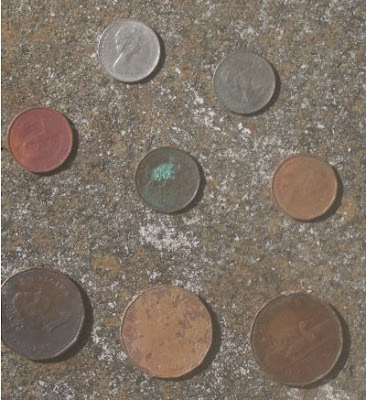Written by the Treasure Guide for the exclusive use of the Treasure Beaches Report.
 |
| Source: see link below. |
Mexico archaeologists reveal tale of cannibalism and reprisal from conquest.
A convoy of Spaniards and allies was ritually sacrificed in 1520 at Tecoaque – ‘the place where they ate them’ – before Hernán Cortés wreaked revenge...
Residents of Tecoaque, also known as Zultepec, captured a convoy of about 15 male Spaniards, 50 women and 10 children, 45 foot soldiers who included Cubans of African and Indigenous descent, and about 350 allies from Indigenous groups in 1520. All were apparently sacrificed over the space of months.
When he heard about it, the conquistador Hernan Cortes ordered Gonzalo de Sandoval to destroy the town in revenge in early 1521...
Here is the link for more about that.
I did a little experiment - although it wasn't much of an experiment. More of an observation. The coins used included two dimes, three pennies, and three one-dollar loons (shown above). The dates were 1975 and 1976 for the dimes. The three one cent coins were 1983, 1983 and I couldn't tell the date on the third. The three loons were 1990, 1989, and 1987. The dimes and loons were very magnetic and the pennies were not. I used the Minelab Equinox.
Mexico archaeologists reveal tale of cannibalism and reprisal from conquest | Mexico | The Guardian
---
 |
| Canadian Coins Used in Experiment. |
I did a little experiment - although it wasn't much of an experiment. More of an observation. The coins used included two dimes, three pennies, and three one-dollar loons (shown above). The dates were 1975 and 1976 for the dimes. The three one cent coins were 1983, 1983 and I couldn't tell the date on the third. The three loons were 1990, 1989, and 1987. The dimes and loons were very magnetic and the pennies were not. I used the Minelab Equinox.
The conductance numbers of the dimes came up pretty consistently around -7. There was a very good chance you could miss or skip them.
The pennies consistently came up as 24 or 25.
In a discrimination mode, the loons were produced very low numbers very much like the dimes except for the 1987, which often came up as a 14. In the all -metals mode the loons consistently produced a -6.
You would expect the magnetic coins to produce low numbers, and they did. If you discriminate iron, there is a very good chance you would miss both the dimes and loons.
It is not surprising that some foreign coins produce signals and conductance numbers very different from U. S. coins, but you might want to be aware of that when hunting. And if you've found a lot of Canadian pennies but not dimes, now you know one possible reason.
The most surprising observation for me was that the 1987 loon produced conductance numbers that were a lot higher than the other two loons. Is it possible that the first year of issue coins were made of a different alloy. A little additional research should answer that question.
The difference was not due to the 87 loonie being positioned differently. All three were laying flat.
I just read that the composition of the loon was changed once - in 2012, but that doesn't answer my question. Here is that information.
There are both U.S and foreign coins that were made of the wrong metal and are valuable rarities, so watch out for coins that are not supposed to be magnetic but are and vice versa.
Here is a little more information about magnetic and non-magnetic coins.
Coins made of iron or nickel would normally be magnetic. Exceptions are alloys, where the exact composition determines whether the charges of the atoms align (there are magnetic and non-magnetic variants of stainless steel).
During World War II, US pennies were made of zinc-plated steel, and hence were magnetic. US nickels (5 cents) are 75% zinc and 25% nickel, and are not magnetic, and neither are the "clad" copper-sandwich coins or the dollar coins that are made of brass.
Canadian nickels have been made of magnetic alloys several times, most recently 99% nickel from 1954 to 2000, and from coated steel since then.
[NOTICE: Subsequent attempts revealed that when the all-metals was used, all three of the loons produced a relatively consistent -6 conductivity number. The earlier observed difference between the 1987 and other loons could have been some undetermined effect, maybe a difference the ground under the 1987.]
---
Do you recognize this bug? Very bright colors. I don't know what it is.
---
Still looks like we'll get something like a 3 - 5 foot surf near the end of the week.
Happy hunting,
TreasureGuide@comcast.net

